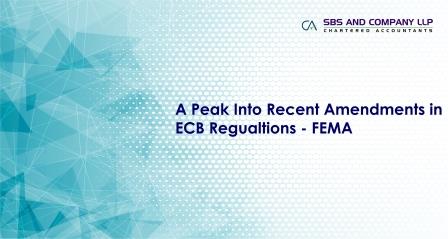A PEAK INTO RECENT AMENDMENTS TO EXTERNAL COMMERCIAL BORROWINGS REGULATIONS
External Commercial Borrowings (ECB) are governed by Foreign Exchange Management (Borrowing or Lending in Foreign Currency) Regulations, 2000 issued by Reserve Bank of India (RBI), and these regulations have been amended from time to time considering changes in India’s macro-economic scenario. Apart from issuing Regulations, RBI has been issuing Master Directions on various aspects connected with foreign exchange management by consolidating related Notifications and AP (DIR Series) Circulars. Master Direction No. 5 on External Commercial Borrowings, Trade Credits, Borrowing and Lending in Foreign Currency by Authorized Dealers / Persons other than Authorized Dealers was issued on January 1, 2016, and RBI has been amending the same in line with amendments to related Regulations, Notifications and new AP (DIR Series) Circulars.
This article throws light on recent amendments to ECB regulations and accordingly to corresponding Master Direction. However, to have better understanding of the amendments, related provisions / guidelines are provided for reference.
For more information on ECB, our article on captioned subject published in SBS Wiki Journal of August 2018 may please be referred, which is available at https://www.sbsandco.com/wiki/document/sbs-wiki-e-journal-aug-2018
Definition and Forms of ECB:
ECBs are commercial loans raised by eligible resident entities from recognised non-resident entities and they should conform to parameters such as permitted borrowers, recognised lenders, minimum average maturity, permitted end-uses, maximum all-in-cost ceiling, etc.
The ECB Framework enables permitted resident entities to borrow from recognized non-resident entities in the following forms:
- Loans including bank loans;
- Securitized instruments (e.g. floating rate notes and fixed rate bonds, non-convertible, optionally convertible or partially convertible preference shares / debentures);
- Buyers’ credit;
- Suppliers’ credit;
- Foreign Currency Convertible Bonds (FCCBs);
- Financial Lease; and
Foreign Currency Exchangeable Bonds (FCEBs)
Borrowing Limits:
Under Automatic Route, ie., without approval of RBI, entities can raise ECB as below, per financial year:
- Companies in infrastructure and manufacturing sectors, NBFC-IFC, NBFC-AFC, Holding Companies and Core Investment Companies – Up to USD 750 Mn or equivalent
- Companies in software development sector – Up to USD 200 Mn or equivalent
- Entities engaged in micro finance activities – Up to USD 100 Mn or equivalent
- All other entities – Up to USD 500 Mn or equivalent
Borrowings beyond the above limits shall be under Approval Route. For borrowings under Track III, i.e., rupee denominated borrowings, the limits shall be computed taking exchange rate prevailing on the date of agreement.
End Use of Proceeds - Prohibition:
Regulations governing ECB expressly prohibit usage of such proceeds for below purposes:
- Borrowings under Track I to III
- Onward lending
- Investment in Capital Markets
- Equity Investment domestically
- Investment in real estate sector or acquisition of land, except for affordable housing projects, SEZs and Industrial Parks & Integrated Townships
- Borrowings under Track I and II
- Working Capital Purpose
- General Corporate Purpose
- Repayment of Rupee Loans
Provisions of clause (b) above are not applicable for borrowings with minimum average maturity period of more than 5 years from direct and indirect equity holders of borrowing entities, which means such proceeds can be used for working capital and other purposes mentioned above.
Rupee Denominated Bonds Overseas (RDBOs):
ECB through RDBOs can be raised by any corporate, REIT and INVITs. Any RDBO shall be under approval route only. Minimum average maturity period for RDBOs shall be 3 years for borrowings up to USD 50 Mn or equivalent per financial year, and 5 years for borrowings above USD 50 Mn per financial year. Indian Banks can also raise funds under this mode subject to other prudential norms and can act as arrangers and underwriters for RDBOs raised overseas by others. In case, an Indian bank underwrites any such issue, it should ensure that it doesn’t hold more than 5% of issue size after 6 months of such issue.
Hedging Requirements:
Eligible Borrowers as mentioned in table above, shall have a Board approved risk management policy and shall always keep their ECB exposure hedged 100 per cent. Also, the concerned Authorized Dealer Bank shall verify the compliance of this hedging requirement and periodically report to RBI though ECB – 2 returns. Also, the entities raising ECB under the provisions of Tracks I and II are required to follow the guidelines for hedging issued, if any, by the concerned sectoral or prudential regulator in respect of foreign currency exposure.
Recent Amendments:
- RBI vide its AP (DIR Series) Circular No. 9 dated September 19, 2018 has amended above mentioned Master Direction, and brought the below listed changes:
- Companies engaged in manufacturing sector can now raise ECB up to USD 50 Mn or its equivalent with a minimum average maturity period of 1 year, as opposed to 3-year period applicable to others.
- Indian banks are now permitted to participate as arrangers/underwriters/market makers/traders in RDBOs issued overseas, subject to applicable prudential norms. And the condition of holding not more than 5% of issue size after 6 months of issue is removed.
- RBI vide its AP (DIR Series) Circular No. 10 dated October 3, 2018 has further amended above mentioned Master Direction, and brought the below listed changes:
- Public Sector Oil Marketing Companies (OMCs), like IOCL, BCPL, HPCL, etc, are now permitted to use ECB proceeds raised from any recognized lenders for working capital purposes with minimum average maturity period of 3/5 years. In case of others, as mentioned above, ECB proceeds from direct or indirect equity holders only can be used for working capital purposes.
- The individual borrowing limit of USD 750 million or equivalent and mandatory hedging requirements as per the ECB framework have also been waived for OMCs. However, OMCs should have a Board approved forex mark to market procedure and prudent risk management policy, for such ECBs.
- The overall ceiling for such ECBs by OMCs has been increased to USD 10 billion equivalent with effect from the date of this Circular.



